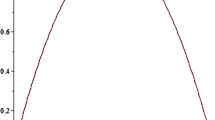Abstract
Measuring the proportionality of outcomes in termsof each party's vote and seatshares is an important task in electoral analysis.Various indexes have been designedthat provide a summary statistic of electoralproportionality/disproportionality. Claimsand counter-claims have been made regarding thestrengths and weaknesses of particularindexes. Important consequences follow from thismethodological pluralism. First, it isnot always clear which index has been employedwhen particular electoral outcomesare discussed. Second, recent additions to thelist of indexes have not been thoroughlyscrutinised and appraised. Third, the lack ofknowledge about the general relationshipbetween indexes means that observations might bedifferent had a different index beenused. This article seeks to identify and clarifythe particular properties of different indexesof proportionality. Relatively new, and largelyuntested, indexes of proportionality areexamined and some unusual and potentially damagingproperties are identified. We alsocompare different measures of disproportionality inan effort to specify some generalproperties of the inter-relationships between them.Understanding the particular patternsof electoral competition and vote distributionsthat affect the relationship between thesemeasures should enable users to anticipate theconsequences of preferring one index overothers.
Similar content being viewed by others
References
Anckar, C. (1997). Determinants of disproportionality and wasted votes. Electoral Studies 16: 501–515.
Benoit, K. (2000). Which electoral formula is the most proportional? A new look with new evidence. Political Analysis 8(4): 381–388.
Cox, G. W. & Shugart, M. S. (1991). Comment on Gallagher's “Proportionality, disproportionality and electoral systems. Electoral Studies 10: 348.
Dorling, D. F. L., Pattie, C. & Johnston, R. J. (2001). Measuring electoral change in three-party systems: An alternative to swing. PS: Political Science and Politics 26: 737–741.
Dunleavy P. & Margetts, M. (1999). Proportional Representation for Local Government. York: York Publishing Services.
Gallagher, M. (1991). Proportionality, disproportionality and electoral systems. Electoral Studies 10: 33–51.
Katz, J. N. & King, G. (2001). A statistical model for multiparty electoral data. American Political Science Review 93: 15–32.
Katz, R. S. (1999). Democracy and Elections. New York: Oxford University Press.
Lijphart, A. (1994). Electoral Systems and Party Systems: A Study of Twenty-Seven Democracies, 1945–1990. Oxford: Oxford University Press.
Loosemore J. & Hanby V. (1971). The theoretical limits of maximum distortion: Some analytic expressions for electoral systems. British Journal of Political Science 1: 467–477.
Monroe, B. L. (1994). Disproportionality and malapportionment: Measuring electoral inequity. Electoral Studies 13: 132–149.
Pennisi, A. (1998). Disproportionality indexes and robustness of proportional allocation methods. Electoral Studies 17: 3–19.
Rae, D.W. (1971). The Political Consequences of Electoral Laws. New Haven: Yale University Press.
Rallings, C., Thrasher, M. & Gunter, C. (2000). Proportionality and disproportionality in English county government, 1973–1997. In: P. Cowley, D. Denver, A. T. Russell & L. Harrison (eds), British Elections and Parties Review. London: Frank Cass, v. 10, pp. 216–234.
Riedwyl, H. & Steiner, J. (1995). What is proportionality anyhow? Comparative Politics 27: 357–369.
Taagepera, R. & Shugart, M. S. (1989). Seats and Votes: The Effects and Determinants of Electoral Systems. New Haven: Yale University Press.
Author information
Authors and Affiliations
Rights and permissions
About this article
Cite this article
Borisyuk, G., Rallings, C. & Thrasher, M. Selecting Indexes of Electoral Proportionality: General Properties and Relationships. Quality & Quantity 38, 51–74 (2004). https://doi.org/10.1023/B:QUQU.0000013239.55304.98
Issue Date:
DOI: https://doi.org/10.1023/B:QUQU.0000013239.55304.98




